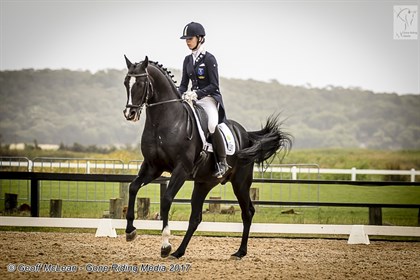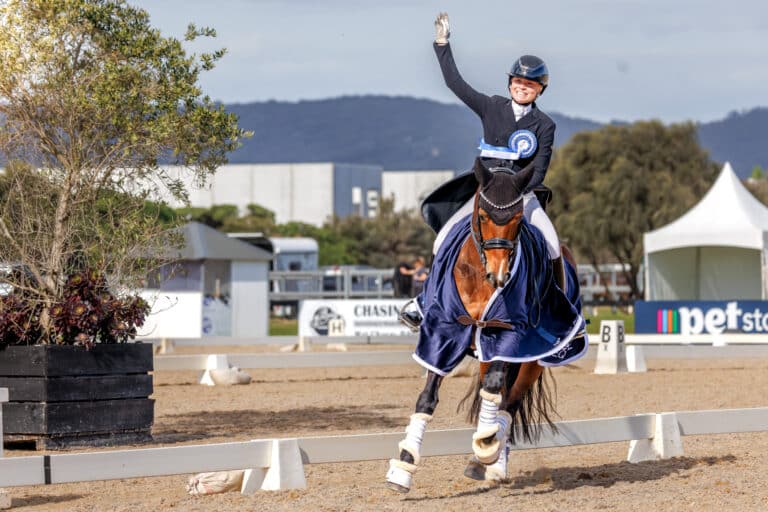© Geoff McLean – Gone Riding Media
Flying Changes – Part I
By Dr Kerry Mack
The winter is a quieter time for competitions and we find it is an excellent opportunity to train the movements above the level the horses are competing. For our younger horses its time to introduce the flying changes, or very gently introducing the work towards piaffe. For the jumping horses it’s a time for grids and gymnastic jumping. Of course it’s always time for flat work for jumping horses, and for cross training. The dressage horses hack out a bit more at this time of year. We like to get them out especially when the weather is bad so they learn to ignore the wind etc.
Of course it’s nice to hack out when the weather is fine, but it’s also important to train the horses to be obedient in all conditions. I have to fess up though, actually I delegate riding in the rain and wind to Kristin White and Tori (I ride inside when its wet). But when Pzazz was younger I rode whatever the weather and I think it helped him become so reliable. At the National Championships one year it was pouring down and blowing a gale when I had to do my advanced test. I was worried that Pzazz would want to just turn his tail into the wind and stop. Of course he wanted to, but he didn’t and we were rewarded with a high placing in spite of the fact that my leather seated breeches became slimy and I slipped all over the place! My point here is don’t let the first time you ride in the rain be in the competition arena.
If you are thinking of introducing the flying changes this winter remember it is (as always) all about the preparation. If you have a 4yo you can still ask very occasionally for a flying change in a simple way, with no pressure. The first time, change on to his supple side. For most horses this is the left, so change right canter to left canter. Just canter a big right circle, change the rein with a figure of 8 and just ask him to canter onto the left leg. If it doesn’t work DO NOT worry. Just trot and change leg. Don’t let him know that that wasn’t what you wanted. But if he changes reward him and make a fuss. Don’t try another one whether it worked or not. Sometimes it is easier to do this between some jumps. Jump on a right circle, land, turn on to a big left circle and change. I think it works well jumping because the rider ensures the canter is active enough to jump, so it will be active enough to change, and the rider tends to be looking up and better balanced, not looking at the shoulder to see if the change has happened. If you look at the shoulder, chances are you will be sitting more over the shoulder, putting more weight forward. To do the changes you want to be sitting more on the hind leg as the change must come from the hind leg.
Doing changes this way with a young or green horse is not the same as training the changes. Only do it occasionally, once every few weeks or months is fine. It just familiarises your horse with the idea. Never be rough! Never punish any attempt to change no matter how clumsy, with a green horse.
You can start to train the changes in a more systematic way when he really understands each canter strike off and preferably can canter off on the correct led from walk reliably and cleanly (no trot steps) each way on a straight line. Counter canter should be established before starting to train the flying changes.
Have fun!
Kerry








